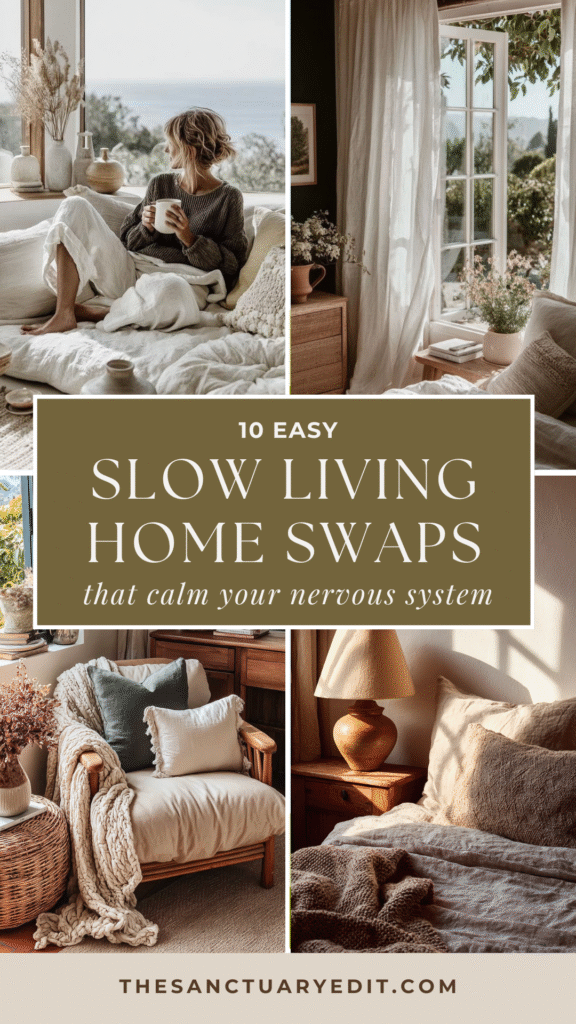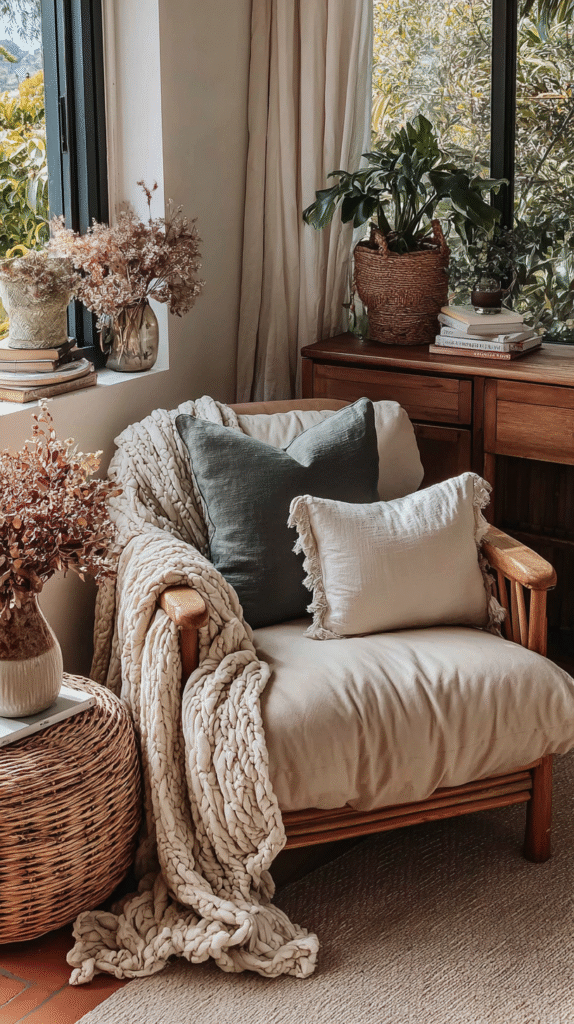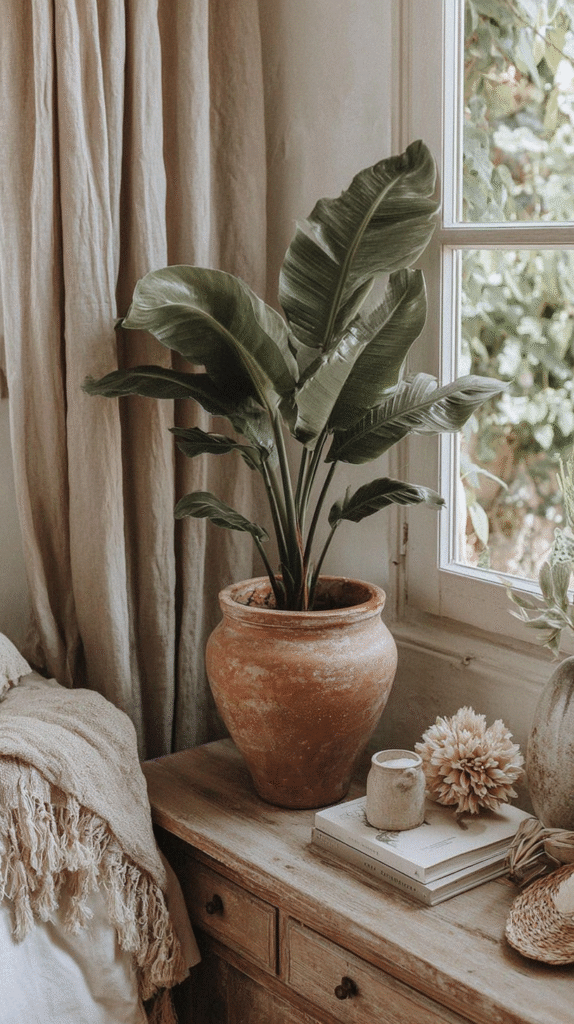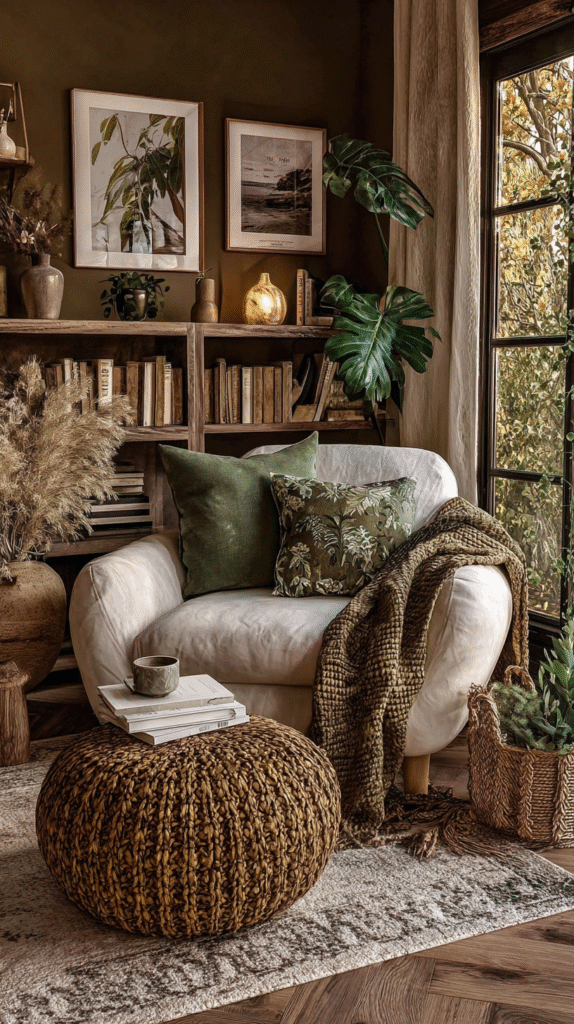This post may contain affiliate links, including those from Amazon Associates. If you make a purchase through these links, I may earn a commission at no additional cost to you. Learn more about our affiliate policy.
Some evenings, your body feels like it hasn’t caught up to your home. The light is too bright, the counters too full, the buzz of the day still running through you. What if your rooms could signal to your nervous system that it’s safe to slow down?
A slow living home isn’t about rigid routines or aesthetic perfection. It’s about creating an environment that helps your body exhale. These ten simple swaps are rooted in sensory design, natural materials, and gentle rhythms.
Each one is easy to integrate and helps shift your space into a nervous system sanctuary.
Why focus on the nervous system?
Your nervous system is constantly scanning for cues of safety or stress. Harsh lighting, clutter, and synthetic scents tell your body to stay on alert. But soft textures, warm tones, and natural rhythms whisper that it’s safe to rest.
Small edits can reduce that hidden sense of bracing and instead invite calm, grounding, and comfort.
If you want to go deeper into designing spaces that actively support your body’s regulation, this guide on creating a peaceful home that supports nervous system regulation offers practical room-by-room ideas.

1. Swap harsh overhead lights for warm, layered glow
Bright overhead lights keep the body in alert mode. Replace them with warm-toned bulbs, dimmable lamps, or clusters of candles.
Think of light as a series of layers: task lighting for focus, soft lamps for evening, flickering beeswax candles for ritual.
The nervous system responds to this gentle cue to slow down, much like watching firelight.

2. Swap synthetic fabrics for natural textures

Polyester throws and shiny curtains may look fine, but they don’t soothe the senses.
Linen, cotton, and wool bring softness you can feel instantly. A linen pillow cover, a wool rug underfoot, or cotton drapes that move with the air all send grounding tactile signals to your body.
Touch is one of the most direct ways to calm the nervous system.
3. Swap cluttered surfaces for breathing room
When every counter is full, your brain works overtime to process it all.
Visual clutter is a hidden stressor. Clear at least one surface and let negative space dominate. Keep only a small bowl, a branch in a vase, or a single candle.
Breathing room for the eyes creates breathing room for the nervous system.
If you want a simple way to start clearing visual noise without overwhelm, try the quick guide on how to create a 15-minute daily decluttering routine for instant calm.
4. Swap plastic decor for living greenery

Biophilic design (bringing nature inside), has been shown to regulate stress.
Replace faux plants or mass-produced wall art with one living plant, a branch clipped from outdoors, or a bowl of fresh fruit on the table.
Here are some of the easiest indoor plants to care for, and that look beautiful in earthy homes.
These small natural presences remind your body of slower rhythms, reconnecting you with seasonal cues that help regulate mood and energy.
5. Swap heavy fragrances for natural scent layers
Artificial sprays and candles can overwhelm the senses. Instead, use subtle, natural scents: eucalyptus branches in a vase, lavender sachets by the bed, or a soy candle with essential oils.
Because smell connects directly to the brain’s emotional center, even a faint natural aroma can help signal safety and calm.
6. Swap busy patterns for grounding tones
The nervous system thrives on predictability.
Bold, high-contrast patterns can feel overstimulating, while earthy tones provide a soft backdrop. Try muted sage, clay, warm beige, or gentle blue-grey in textiles or small accents.
These hues mimic natural environments, offering a subtle sense of steadiness and calm.
For more inspiration, you can explore these calming bedroom colors that help you sleep better, since the tones you choose work alongside lighting to cue rest.
7. Swap flat-pack furniture for soulful, tactile pieces
Furniture made of particleboard or laminate often feels cold and temporary. Instead, choose one piece at a time with weight and texture—wood, rattan, stone, or reclaimed materials.
A solid wooden chair or vintage table tells your body it has something steady to lean on. Authentic textures anchor both space and nervous system.
8. Swap screens for restorative corners

Digital devices keep the mind buzzing. Create at least one corner of your home that is screen-free: a reading chair, a journaling nook, or a meditation cushion by the window.
Even a few minutes spent in this space tells your nervous system that it’s safe to step out of constant input.
For cozy inspiration, try shaping your own hygge reading corner for relaxation, a simple way to create a screen-free retreat that feels restorative and grounding.
9. Swap impulse purchases for intentional edits
Every object in your home sends a signal. Impulse buys often clutter space and drain energy. Pause before bringing something new inside: does it support calm, beauty, or purpose?
Curating with intention reduces decision fatigue and allows the nervous system to rest in an environment that feels aligned rather than chaotic.
If you’re learning to curate your home with more intention, this post on how to start a slow living home one room at a time will help you approach each space with calm, clarity, and purpose instead of impulse.
10. Swap rushed transitions for micro-rituals

The nervous system regulates through rhythm and repetition. Instead of rushing from one task to the next, create small rituals.
In the morning, grounding practices like opening a window for fresh air, lighting a candle, or stretching quietly before reaching for your phone can shift your body into presence.
You can explore more ideas in how to build a slow morning routine for all-day calm, which walks through gentle ways to begin your day in sync with your nervous system.
Evenings invite a slower pace. Try dimming the lights, sipping herbal tea, or journaling before bed to signal the transition toward rest.
For more guidance, 7 slow living evening routines to fall asleep quickly shares simple rituals that help your body wind down naturally.
These swaps don’t add time; they reframe ordinary transitions as grounding moments.
How to begin
Choose just one swap this week. Notice how your body feels afterward, whether the light softens your breath or the uncluttered table quiets your mind.
Slow living is not about doing everything at once. It’s about layering calm gradually, so your nervous system learns to feel at home in your own space.
Closing
Your home can either heighten tension or signal ease. With a few simple swaps, you can shape it into a nervous system sanctuary—one that restores rather than drains. Start small, celebrate each shift, and let the calm accumulate.




